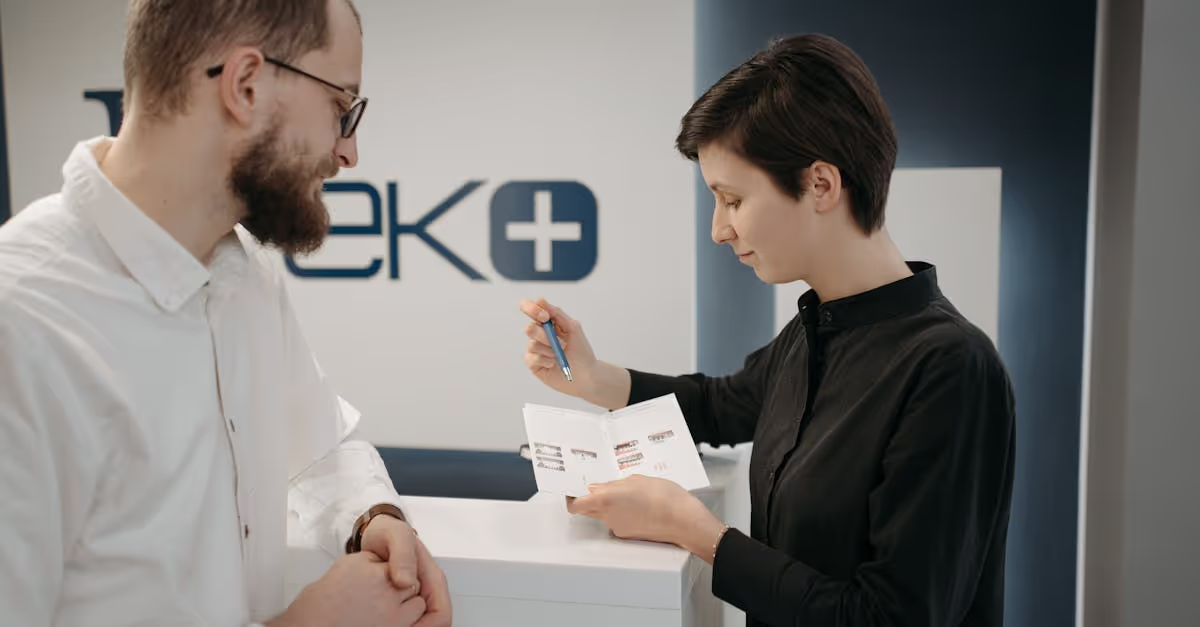Key Takeaways
- Understand Types of Conflict: Familiarize yourself with communication, value, interest, and resource conflicts to address issues effectively with clients.
- Proactive Conflict Management: Utilize open communication and active listening to enhance client engagement and prevent misunderstandings.
- Empathy is Key: Show empathy and understanding to build trust, making clients feel valued and understood during conflicts.
- Collaborative Problem Solving: Approach disputes as opportunities for teamwork by involving clients in creating solutions together.
- Set Clear Expectations: Establish boundaries and define roles from the outset to minimize potential conflicts and misunderstandings.
- Invest in Training: Enhance your team's conflict resolution skills through training, fostering a culture that prioritizes effective communication.
In the world of business, conflicts are inevitable. Studies show that 70% of workplace conflicts stem from miscommunication. When it comes to client relationships, how we handle these disputes can make or break our reputation. Effective conflict resolution not only salvages relationships but also fosters trust and loyalty.
We know that navigating conflicts requires skill and strategy. By embracing proactive communication and understanding differing perspectives, we can turn potential disputes into opportunities for growth. This guide will explore practical strategies to help us maintain positive client relationships, ensuring that every challenge strengthens our bonds rather than weakens them. Let’s dive in and discover how to transform conflict into collaboration.
Understanding Conflict in Client Relationships
Conflicts are a part of any business interaction, especially with clients. Understanding the nature of these conflicts helps us address them effectively and maintain strong relationships.
Types of Conflict
Conflicts can broadly be categorized into several types:
- Communication Conflicts: Misunderstandings in messages or expectations can lead to disputes.
- Value Conflicts: Differing beliefs or principles between clients and service providers create friction.
- Interest Conflicts: Competing interests often occur when priorities clash, impacting the outcome for either party.
- Resource Conflicts: Disputes may arise over the allocation of resources, such as budget and time.
Familiarity with these conflicts helps us identify the underlying issues more quickly. By using tools like service business software or field service automation, we can streamline communication, clarify expectations, and minimize misunderstandings.
Impact of Conflict on Relationships
Conflicts can significantly affect client relationships in various ways:
- Trust Erosion: Unresolved conflicts might damage trust, leading clients to second-guess our capabilities.
- Loyalty Decline: Friction can push clients toward seeking alternatives if their needs aren't met.
- Reputation Risk: Negative experiences can spread through word-of-mouth, impacting ours and others’ client base.
Proactively managing conflicts leads to better outcomes. We can enhance customer engagement for service companies by listening to client concerns and addressing them thoughtfully. Implementing technician management software improves service delivery and responsiveness. Additionally, turning conflicts into learning opportunities fosters collaboration and growth.
What strategies have we utilized to handle conflicts? How have they influenced our client relationships? Sharing experiences makes our community stronger.
Key Principles of Conflict Resolution
Conflict resolution revolves around key principles that can transform disputes into constructive dialogues. We recognize that applying these principles can significantly maintain our positive client relationships.
Active Listening
Active listening involves giving full attention to the speaker and validating their feelings. We focus on understanding their perspective before responding. This means avoiding distractions, such as our phones, and genuinely absorbing what the client expresses. Confirming understanding by summarizing their points shows we value their input. Have we all found ourselves in conversations where we just nod along but miss the important details? This shared experience reminds us how critical it is to engage fully in discussions.
Empathy and Understanding
Empathy forms the cornerstone of effective conflict resolution. We aim to step into the client's shoes, appreciating their emotions and viewpoints. Acknowledging their concerns fosters trust and creates a collaborative environment. When we empathize, we promote mutual respect and reduce defensiveness on both sides. Can we recall a time when a simple “I understand how you feel” made a world of difference? Humor can also lighten the mood. If we can joke about our clumsy attempts to communicate at times, we can build deeper connections. Sharing laughter and validating emotions leads to stronger client bonds.
Effective Conflict Resolution Strategies
Conflicts happen. By utilizing effective conflict resolution strategies, we can maintain strong client relationships. Here are some strategies to consider.
Open Communication
Open communication serves as the foundation for resolving conflicts. We promote transparent discussions where all parties express their feelings and concerns. Active listening becomes vital here; we listen to understand, not just to respond. By inviting clients to share their perspectives, we create a space for collaboration. Consider establishing regular check-ins, which foster a continuous dialogue. Daily or weekly updates help us stay aligned with client needs. Have we checked in enough lately?
Collaborative Problem Solving
Collaborative problem solving transforms disputes into opportunities for teamwork. We work with clients to find solutions together. When we approach issues as partners, we cultivate trust. Techniques such as brainstorming sessions or joint action plans help keep everyone involved. Introducing software solutions, such as service business automation tools, assists in tracking progress and sharing insights. Let’s leverage technology to enhance our collaboration and make conflict resolution easier. What has worked for you in resolving conflicts collaboratively?
Setting Clear Boundaries
Setting clear boundaries clarifies expectations from the start. We define roles, responsibilities, and communication protocols to prevent misunderstandings. When clients know what to expect, they feel more secure in the relationship. Utilizing technician scheduling tools or service dispatch software aids in maintaining organized workflows. Clear boundaries prevent conflicts from escalating. What boundaries have you found most effective in your client relationships?
By applying these strategies, we build a solid framework for maintaining positive client relationships and turning conflicts into meaningful conversations.
Implementing Conflict Resolution Strategies
Effectively managing conflict is crucial for preserving client relationships. By applying specific strategies, we can navigate disputes positively and constructively.
Training and Development
Training and development programs enhance our conflict resolution skills. They equip us with techniques in communication and empathy. Regular workshops on conflict management enable us to practice scenarios that mimic real-life challenges. For instance, role-playing can prepare us for tough conversations with clients.
Investing in training tools, like mobile workforce management software, can streamline scheduling of these sessions, ensuring everyone participates. Encouraging a culture of learning helps us understand diverse perspectives. Workshops could incorporate customer engagement for service companies, aiding us in appreciating clients' emotions.
Companies that prioritize training often notice decreased conflict instances. This approach fosters a unified front, allowing us to address issues more efficiently.
Role of Leadership
Effective leadership plays a vital role in conflict resolution. Leaders set the tone for how conflicts are addressed within teams. They're the ones who model active listening and empathy, creating an environment where all voices are heard.
Leaders who embrace open communication pave the way for conflict to be managed constructively. They can implement software solutions, like service dispatch software, that streamline communication between team members. This clear flow of information reduces misunderstandings.
Sometimes, it just takes a leader to say, “Let’s figure this out together” to turn a heated argument into a productive discussion. By exemplifying teamwork, leaders guide others to collaborate rather than compete. This collaborative spirit enhances overall service delivery and client satisfaction.
Let’s remember that conflict is part of the process. How do we handle it can define our relationships with our clients. What's a memorable experience you’ve had in resolving conflict successfully? Sharing stories can create a supportive community where we learn from each other.
Conclusion
Navigating conflicts is an essential part of our client relationships. By embracing effective conflict resolution strategies we not only safeguard our reputation but also strengthen trust and loyalty. It’s about transforming challenges into opportunities for growth and collaboration.
As we implement these strategies we foster an environment where open communication and empathy thrive. This proactive approach not only enhances our client interactions but also cultivates a supportive community. Let’s commit to continuous improvement in our conflict resolution skills and share our experiences to inspire one another. Together we can create lasting positive relationships with our clients.
Frequently Asked Questions
What causes conflicts in the business world?
Conflicts in the business world often stem from miscommunication, with studies showing that 70% of workplace disputes arise this way. Other causes include differing values, interests, and resources among team members or clients.
How does miscommunication impact client relationships?
Miscommunication can damage client relationships by eroding trust and loyalty, potentially harming a company's reputation. Addressing miscommunication early can prevent conflicts and maintain positive interactions.
What are the types of conflicts in client relationships?
Client relationship conflicts can be categorized into four types: communication, value, interest, and resource conflicts. Understanding these categories helps identify the root causes of disputes quickly.
Why is proactive conflict management important?
Proactive conflict management is crucial as it fosters better outcomes, enhances customer engagement, and encourages collaboration. Taking initiative in resolving conflicts can turn potential issues into opportunities for growth.
What are the key principles of conflict resolution?
Key principles of conflict resolution include active listening and empathy. These techniques help understand different perspectives and validate feelings, promoting trust and facilitating constructive dialogue.
How can open communication improve conflict resolution?
Open communication encourages transparency and regular check-ins, allowing for clear discussions about any issues. This transparency is essential for preventing misunderstandings and maintaining healthy client relationships.
What strategies can be used for effective conflict resolution?
Effective strategies for conflict resolution include open communication, collaborative problem-solving, and setting clear boundaries. These tactics help clarify expectations and promote teamwork during disputes.
How does leadership influence conflict resolution?
Leadership plays a critical role in conflict resolution by modeling active listening and empathy. Effective leaders create an environment of open communication, guiding their teams to handle conflicts constructively.
Why is training important for conflict resolution skills?
Training enhances conflict resolution skills by equipping individuals with techniques in communication and empathy. Regular workshops and role-playing scenarios prepare team members to handle disputes more effectively.
How can sharing experiences strengthen community relationships?
Sharing successful conflict resolution experiences builds a supportive community and creates a culture of collaboration. This collective knowledge encourages others to learn from past challenges and foster positive relationships.





